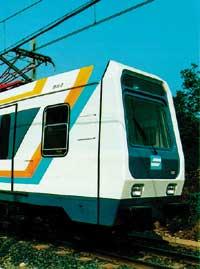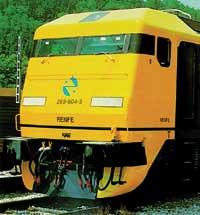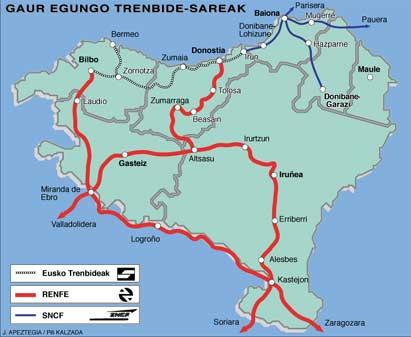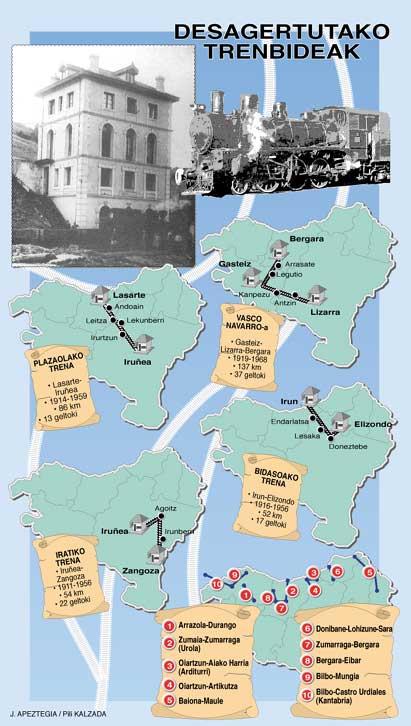Between loves and enemies
“How is it said that the man who made the boiling water is precious to always be on the hip? I have no other food if I am well explored by fire, smoke and chidar, if I have cold strength.”
“The wisdom of my world has been very superficial I ask God, although I will clarify that before we did not know that he was an electrician who now fed on cold waters as he had before”
Between loves and enemies

The first remains of the current railway network of the Basque Country date from 1832. The connection between Bilbao and Great Britain is known and, with the intention of bringing its experiences, the train project between Bilbao and Balmaseda began to take shape at that time, despite the circumstances of the war. In Navarre, meanwhile, the train that would unite Pamplona and Zaragoza came true very soon after.
The train was first seen in Euskal Herria in Lapurdi. At the initiative of the MIDI company, founded by the Pereire brothers, the idea of joining Bordeaux and lrun has materialized for some time, when the steam engine from Dax arrived in Baiona on the L854.
Ten years later he saw the first major railway network that would cross the South. The Pereire brothers were, as in Iparralde, in charge of carrying out this network. They created the Company of the Northern Roads. However, according to this project, the train would run through Bilbao and Vitoria-Gasteiz to the detriment of the new growing industry in Bizkaia.

Consequently, several associations in Bilbao claimed the need to create a railway network that would unite the capital with Tudela and meet in Miranda with the Compañía del Norte. According to the chronicles of the time, the Biscayan and Biscayan obtained the surprise money and the train created with the effort of the Bilbao people who were about to start up a year before the arrival of the first train of the Northern Company.
The train linking Bilbao and Durango was born in 1882, strongly promoted by the group “Locos del Durangillo”. It was about getting a ‘cheap’ railroad, for which a narrow lane width project was presented and prioritized. The model was extended to most of the railway networks that were about to be born in the Southern Basque Country and, for reasons of economic and technical efficiency, in the Basque Country the roads of one meter wide predominated.
The years before the Civil War were abundant in the Basque railway sector. The networks were expanded and vehicles were equipped with the most advanced technology of the time. From the current point of view, the most significant change is undoubtedly the abandonment of the steam used until then to move trains and the installation of electricity. It was already known on the roads of Bilbao and San Sebastian, but at that time it extended to the main railway networks facilitating its maintenance. As a result, steam lost importance and was limited to small networks.
Years of great boom

The 90s caused the decline of the Basque railway. Road transport was promoted and, as a result, investments in the construction of railway networks were avoided. The inter-urban railway, in its beginnings and others, began to weaken in the immense railway network that gave prestige to the Basque Country. Moreover, at this time the railway property was transferred. The passage from private to public hands seriously affected the small railway companies of Euskal Herria. Many of them could not raise their heads since publication.
The steps to follow are better known to all. Improved networks, noticeable and spectacular changes, but much remains to recover the train. The railway network of the Basque Country has lost a lot along the way. The disappearance of the Tren del Urola, for example, is not an easy decision to understand.
The missing trains have left a big gap and it doesn't seem to be filling. The short-term perspective has left us tremendous consequences in the medium term.

Also distributed by rails
We know that North trains have a European width of 1.44 m, while South trains are 1.67 m. Why? There have been many reasons to justify a historical error. It has been said that it was a military strategy, but the intention of getting more powerful trains is the one behind this implementation that today is considered absurd, since it was considered that the widest railways brought more powerful locomotives. The “strategists” of the time realized that this would move us away from Europe later or too late.

Basque Railway Museum
Years have passed and since the first steam engine arrived at Baiona station it has rained a lot. Time has not gone unsuccessfully and the debt we have with the train that has had a great weight in the history of Euskal Herria has recently begun to settle. The Basque Railway Museum, which can be visited at the Old Azpeitia Station, is a clear and vivid example of this.
Visiting their workshops and exhibitions, we can appreciate the importance of the train in our history. The offer consists of the collection of watches from the old stations, steam engines, early century control systems, diesel locomotives, etc. The march of time slows down in the Museum, where with stops in the most significant moments you can travel through the history of Euskal Herria. By train, of course.





